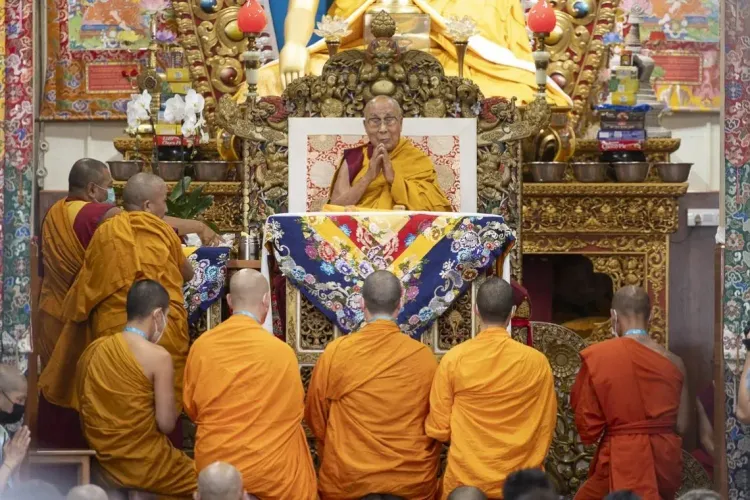Is Dharamshala More Than Just a Tibetan Refuge?

Synopsis
Key Takeaways
- Dharamshala is the spiritual and political center for Tibetans in exile.
- The 14th Dalai Lama's leadership has transformed the town into a hub of global ethics.
- Institutions in Dharamshala preserve and promote Tibetan culture and philosophy.
- The Dalai Lama's teachings inspire compassion and sustainable living.
- Dharamshala serves as a bridge between Tibetan and Indian Buddhism.
Kathmandu: Dharamshala, situated in the magnificent Dhauladhar range of Himachal Pradesh, has emerged as a globally acknowledged destination renowned not just for its scenic beauty but also as a pivotal spiritual and political hub for the Tibetan community. This evolution is primarily attributed to the influence of His Holiness, the 14th Dalai Lama, who transformed this area into a living karmabhoomi, a sacred ground of righteous action.
Today, often referred to as "Little Lhasa", Dharamshala functions as the unofficial capital for Tibetans in exile and stands as a symbol of Buddhist principles, intercultural dialogue, and global ethics. Nestled in the Kangra district, it is divided into Lower Dharamshala (the administrative zone) and Upper Dharamshala or McLeodganj, which hosts the Dalai Lama and the Tibetan populace. Surrounded by snow-capped peaks and lush forests, this region provides an ideal setting for meditation and spiritual pursuits. Historically, it was part of the Trigarta kingdom and later evolved into a British cantonment. After a devastating earthquake in 1905, the town saw a decline until it experienced a spiritual renaissance with the Dalai Lama's arrival.
In 1959, following the Chinese crackdown on the Tibetan uprising, the Dalai Lama fled Tibet with approximately 80,000 followers. India offered him asylum, and in 1960, Dharamshala was selected as the site for the Central Tibetan Administration (CTA). This marked a significant shift in Dharamshala's spiritual and political identity. Under the Dalai Lama's leadership, schools, monasteries, and institutions began to prosper, promoting non-violence (ahimsa), compassion (karuna), and universal accountability. The establishment of organizations like the Library of Tibetan Works and Archives (LTWA) in 1970 and the Institute of Buddhist Dialectics (IBD) in 1973 highlighted key achievements in safeguarding Tibetan culture and philosophy. The LTWA is home to priceless manuscripts, while the IBD perpetuates the Nalanda tradition of debate, philosophy, and logic. Other significant monasteries, such as Namgyal Monastery and Gyuto Tantric Monastery, further enhance Dharamshala's spiritual depth.
Dharamshala is more than a refuge; it is a vital center of global moral leadership. The teachings and diplomatic initiatives of the Dalai Lama have resonated with over sixty nations, engaging prominent figures like Barack Obama and Pope John Paul II. His message of "universal responsibility" underscores that global peace arises from individual compassion. This ethical vision has led to various secular ethics programs worldwide, including the Dalai Lama Centre for Ethics and Transformative Values at MIT. These efforts incorporate Buddhist principles such as interdependence and mindfulness, framing them in universal human contexts to appeal to a wider audience. The Dalai Lama's ecological perspective is rooted in Buddhist teachings on interdependence (pratītyasamutpada) and non-harming (ahiṃsa). He advocates for sustainable living and environmental stewardship as spiritual obligations. Cultural entities like the Norbulingka Institute further aid in preserving Tibetan arts, music, and crafts, solidifying Tibetan identity in exile.
Although a Tibetan spiritual leader, the Dalai Lama has significantly revitalized Indian Buddhism. He frequently reminds Indians that while India is the "guru" and Tibet the "disciple", it is the Tibetans who have maintained India's ancient Buddhist wisdom. His teachings in locations such as Bodh Gaya and Sarnath have rekindled Indian interest in Buddhism, particularly among Dalits inspired by Dr. B.R. Ambedkar. Institutions like the Central Institute of Higher Tibetan Studies in Sarnath and the LTWA serve as hubs for Indo-Tibetan Buddhist scholarship. The Dalai Lama has also promoted translations of Tibetan texts into Sanskrit and Hindi, aiding Indian audiences in reconnecting with their spiritual heritage.
The Nalanda tradition, once thriving at the historic Indian monastic university between the 5th and 12th centuries CE, underpins Tibetan Buddhism. Emphasizing dialectical reasoning, rigorous scholarship, and ethical behavior, this tradition persists through Tibetan monastic curricula in exile. Texts by Nagarjuna, Asanga, Dharmakīrti, and Śantarakṣita remain central. Institutions such as the revived monastic universities, Sera, Drepung, and Ganden, carry forward the Nalanda heritage. In Dharamshala, the Institute of Buddhist Dialectics acts as the custodian of these traditions. Tibetan monks undergo years of training culminating in the Geshe degree, engaging thoroughly with logic and debate rather than faith alone. The Dalai Lama has broadened the Nalanda tradition beyond religious confines, advocating for its logical and ethical frameworks as instruments for secular education. In works like Beyond Religion and Ethics for the New Millennium, he champions an "education of the heart", merging reason with compassion. His scientific inquisitiveness has sparked dialogues between Buddhist psychology and contemporary neuroscience, particularly through the Mind and Life Institute, connecting ancient contemplative insights with cognitive science. The Dalai Lama's reference to Nalanda also symbolizes India's Buddhist legacy. His remark, "India is the guru; Tibet is the disciple", has resonated with Indian leaders, inspiring initiatives to revive Buddhist scholarship and heritage sites. For Tibetans, the Nalanda lineage offers continuity and identity; for the world, it presents an ethically rooted, rational spirituality.
As His Holiness the Dalai Lama celebrates his 90th birthday, this occasion transcends personal significance, serving as a global moment for contemplation. His teachings bridge the spiritual and secular, East and West, tradition and science. His fundamental message—that genuine transformation starts from within and that kindness lies at the core of religion—continues to motivate millions. Under his leadership, Dharamshala has transformed into a sacred landscape, a mandala where Tibetan identity is nurtured, Buddhist teachings thrive, and universal values are imparted. Visitors from across the globe come to engage with his teachings at the Tsuglagkhang Complex, often translated live into various languages. Notable Western monastics like Pema Chodron and Thubten Chodron have trained here, helping disseminate Tibetan teachings worldwide. The Central Tibetan Administration (CTA) exemplifies a model of democratic governance in exile, prioritizing non-violence and dialogue over conflict. Dharamshala's metamorphosis from a colonial cantonment into a moral nucleus illustrates how compassion and ethical leadership can rejuvenate a community. In conclusion, Dharamshala is not merely a sanctuary for exiled Tibetans; it is a karmabhoomi for the entire world, sanctified not by authority but by compassion, guided by the enduring wisdom of the 14th Dalai Lama.
(The writer currently leads the Ambedkar Chair for Buddhist Studies at Lumbini University, Nepal. The views expressed are personal.)









